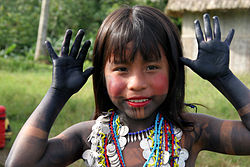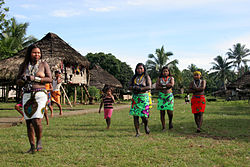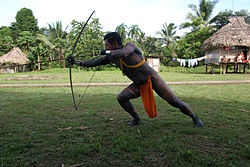- Embera-Wounaan
-
Embera–Wounaan
ChocóTotal population 15,000–16,000
(9,000–10,000 Embera and 6,000 Wuanana)[1]Regions with significant populations  Colombia,
Colombia,  Panama
PanamaLanguages Related ethnic groups Caramanta people, Catío people
The Embera–Wounaan are a group of semi-nomadic Indians in Panama, living in the province of Darien at the shores of the Chucunaque, Sambu, Tuira Rivers and its water ways. The Embera-Wounaan were formerly and widely known by the name Chocó, and they speak the Embera and Wounaan languages, part of the Chocoan language family.
Contents
Name
The name "Emebera" means "people." Collectively they are known as the Chocó and belong to two major groups: the Embirá, of upper Atrato and San Juan Rivers, and the Wuanana of the lower San Juan River. The Emirá are also known as the Atrato, Bedea, Cholo, Darién, Dariena, Eberá, Emberá, Emberak, Emperia, and Panama Emberá people. The Waunana are also known as the Chanco, Chocama, Noanama, Noenama, Nonama, Wounaan, or Wound Meu people. A third group of Chocó are called the Catío, who are also called the Embena, Epera, Eyabida, or Katio people.[1]
Housing
The Chocó Indians live in small villages of 10 to 20 houses along the banks of the rivers throughout the main Chucunaque/Tuira/Balsas basin of the Darien of Panama. There are generally three villages on each tributary that branches off from the main river system. Each village was about a half day's walk to the next village. Closer to a village, the jungle topography on the shores begins to change, and there is less jungle and more plantain fields. The villages are built on a small rise, set approximately 100 feet in from the river. The hill leading down to the river from the village is hard packed with smooth reddish dirt. There are large rocks in the river by the banks, and one can see young, naked children playing on the shore and in the shallows as the dugout canoe pulls up to the banks. The houses of the village are set atop the rise and stand out as they are raised on poles and have tall thatched roofs.
Their houses are raised off the ground about eight feet. Each house stands on several large logs and has a thatched roof made from large palm leaves. All the joints are tied together with vines. There are no walls to the house. Hanging from the supporting log beams were baskets, pots, bows and arrows and other items that had been hand fashioned for fishing or hunting. The floor is made of split cana blanca (white cane), and at one end was the kitchen. This consists of a clay platform that was about three feet square; on top of this base they set the logs for the fire, supporting the cooking pot over the fire by using a tripod of sturdy sticks. The Chocó would climb to the house on a log that had notches in it to serve as a ladder. They would turn the notches facing down at night so wild animals cannot climb into the house while they slept.
Society
The Chocó are a matriarchal society and live in family units based around lineage through the mother's side of the family. The cacique, or chief, of the Chocó lived in the largest village and capitol of the Chocó Nation, named Unión Chocó. The city is on the banks of the Rio Tuira.
The Chocó have their own form of government and live by their own set of laws. They appear to have little or no contact with the Guardia Nacional or the Panamanian government. They tend to ignore any governmental rules or regulations, and the Guardia leaves them alone. They were never assimilated into Panamanian society, and Chocó Indians have not held a civic position or had one who was a member of the Guardia.
The Chocó are not known for intermarrying with the Panamanians and Colombians.
The land is community owned and community farmed. Everyone in the village pitches in to work at harvest time. If someone kills a puerco de monte while hunting during the day and brings it back to town, everybody in the village eats puerco de monte that night.
Subsistence
The calabash tree is an important resource for the Choco. They scooped out the gourds from this tree and used them for both eating and drinking. They would then fashion spoons out of pieces of these same gourds.
Appearance
The men wear loin cloths, the women wear brightly colored materials wrapped at the waist, which look like skirts. The men and the woman have long, straight black hair and wear no clothing from the waist up. The little kids go naked most of the time, and no one wears shoes.
They paint their bodies with a dye made from the berry of the genip tree. They completely coat their bodies with the black dye, which can repel insects at night. On special occasions, they use this same dye and paint their bodies in intricate geometric patterns. The women also wear silver necklaces and silver earrings on these special occasions; many of the necklaces were made with old silver dollars and silver half dollars. They punch a hole in the coin and run a silver chain through it. Many of the coins on these necklaces date to the 19th century and have been passed down from mother to daughter.
See also
- Comarca Emberá-Wounaan, indigenous territory in Panama
Notes
External links
Categories:- Ethnic groups in Panama
- Indigenous peoples in Panama
- Indigenous peoples in Colombia
- Indigenous peoples of Central America
Wikimedia Foundation. 2010.



